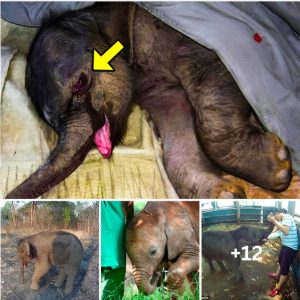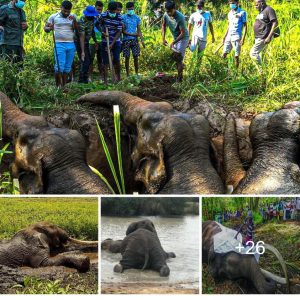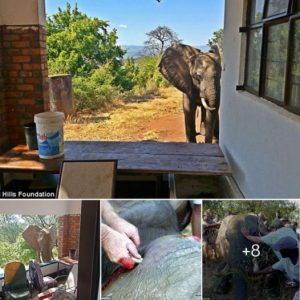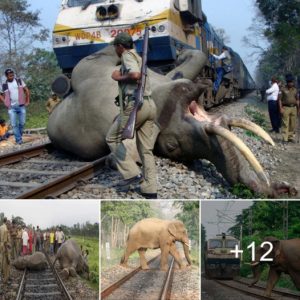A significant strategy in keeping Eyes on the Elephants once they are released is through satellite collar technology and at GRI we have been implementing this valuable remote monitoring tool with the orphans since 2015. However, in nearly all orphan collaring operations to date, the orphans were still part of the Kafue Release Facility herd and usually returning to the boma each night. This provided a very controlled and safe opportunity to sedate the elephants for collar implementation. Now, for the first time in our history, under Chamilandu’s leadership we finally have a ‘released herd’ of orphans moving freely in Kafue National Park together, completely independent of the Release Facility. Not all these elephants had a functioning satellite collar, and with thanks to IFAW we received some new GPS collars, so it was a momentous occasion when we recently collared Chamilandu’s herd in the wild, treating them the same as any other wild elephants!

Chamilandu (left), now 17 years old, has displayed strong matriarchal qualities since her early years and this is evident in her abilities to keep together her current herd which is comprised of all male elephants Tafika (14.5yrs), Mosi (13yrs), Rufunsa (13yrs, right) and her calf Mutaanzi (middle) who will soon be 4 years old. These older male elephants should naturally be dispersing from their herd at this age, but their presence provides the added security that Chamma needs for the more vulnerable, smaller, Mutaanzi against predators.
To safely collar elephants in the wild aerial support is required, The GRI fixed wing savannah plane was used to track and locate the orphans and thanks to our partners at African Parks (AP), we were then able to utilize their helicopter to ensure the elephants were in a good location to then dart the orphans from the sky. Our aim was to sedate and collar the elephants one-time to minimize stress to the herd, however, once an elephant is darted it can take a few minutes to succumb to the sedation and in which time the herd can disperse, so to ensure welfare the Department of National Parks and Wildlife (DNPW) provided 3 vets for the operation, led by Principal Vet, Dr Innocent Ng’ombwa. We also had three grounds teams ready to assist in collar fitment, collection of biological samples and to support the monitoring of vitals.

The AP helicopter was flown low and steady to enable the DNPW vet to dart the orphans with precision,
requiring incredible skill by both vet and pilot
GRI’s Research Coordinator, Webster Mwaanga, was on the ground coordinating the operation and reported…

“Chamma’s herd have been moving together for nearly a year, so we were provisioned to collar the herd as a unit. However, on the morning of the operation Tafika provided us with a perfect opportunity when he made a guest appearance at the dry season boma. Since he was virtually on camp it was easy and safe for us to dart him from the ground as the landscape was grassy plains with few trees, so it was easy to maintain visual of him until he laid down. The grounds team then quickly moved in to replace his expired collar and within 15 minutes the sedation was reversed, and Tafika was getting back up on his feet.
We then proceeded to track the rest of Chamma’s herd by plane and ground simultaneously using a VHF receiver since none of the GPS collars were still functioning. It took many hours to locate them, but eventually they were found Southeast of the Release Facility, in the company of another sub-adult bull elephant.
Research Coordinator, Webster Mwaanga
Highly skilled AP helicopter pilot, Brad, pushed the herd into an open area for Dr Innocent to dart, but in the process Mosi and Rufunsa separated from Chamilandu and Mutaanzi and the wild bull stayed with Chamma. With good positioning in the open, the vet darted Chamilandu and Mutaanzi. The wild bull refused to leave their side and showed defensive behaviours over Mutaanzi, so for safety he was also sedated.

Chamma’s herd spotted by air: Chamma (left), Mutaanzi and a wild bull bunched together, with Mosi and Rufunsa who peeled off at the back
As soon as the elephants had gone down the helicopter landed, and the ground teams were able to move in. Chamilandu was quickly collared whilst Mutaanzi and the wild bull were stabilized.


(LEFT) Keeping Chamma cool and monitoring her vitals as her collar is replaced. (RIGHT) Mutaanzi David was stabilised under sedation whilst his mum’s collar was replaced. His reliance on her for a few more years means there is no need to collar him as he will not leave her side. Despite being born amongst the KRF herd, Mutaanzi has never intentionally been handled so these opportunities to get close to him to assess his health and growth provide us with an incredibly useful benchmark for orphaned elephant progress monitoring.
This provided us with a good opportunity to collect biological samples (blood, dung, tail hair) and take growth measurements from all three elephants. The process went very smoothly with all three elephants soon back on their feet and this marked the end of the first day of collaring as it was getting late. We hoped that overnight Mosi and Rufunsa would reunite with now collared Tafika or Chamilandu.”
The next day the newly deployed collars on Tafika and Chamilandu were set to issue frequent GPS positions and the GRI plane took to the sky as teams also headed out on the ground, guided by the new-collar readings. We were quick to locate Chamilandu’s herd and found that overnight Mosi and Rufunsa had reunited with them as hoped. The helicopter team was then called in to ensure these two sub-adult bulls were driven into a safe location for darting.
Elephants are a family-oriented species and in the wild a breeding herd is mostly comprised of closely related individuals. But with the case of the orphans, they have made these bonds from living together over the years and supporting each other to overcome the trauma of their initial losses. Elephants when threatened bunch up for defence and this is often the response seen when a helicopter comes close overhead. Despite Chamilandu’s herd being a surrogate herd, we were pleased to see these responsive wild and natural behaviours exhibited by the orphans as they bunched up and followed Chamilandu as their matriarch.
Rufunsa, and then Mosi were successfully sedated and the grounds teams quickly moved in to stabilise them, fit the collars and collect samples. When Mosi went down, he remained on his knees, so the team were quick to push him onto his side. Due to an elephants’ immense weight, it puts too much pressure on their diaphragm if they go down and tip forwards, and this is where access to manpower is essential to prevent accidental suffocation. Mosi was quickly moved on his side with his trunk stretched out straight for a clear airway as this collar was replaced.”

Heave-ho! The team are quick to push Mosi and help him onto his right side to ensure a good position while he is under anaesthesia.
With the four teenage elephants now collared we really have been able to get a much better insight into the released herd’s dynamics. Although they are witnessed together frequently, we are now understanding more about their progress, and in particular Tafika’s demonstration of independence as he splits away from to Chamma’s herd more regularly than we had realised. Having Eyes on the Elephants and this greater depth of knowledge will inform our release strategy moving forwards as we learn from every elephant’s progress and individual journey. Mosi and Rufunsa have also taken some bold steps away from Chamilandu recently and this provides us with further reassurance that despite their traumatic and unconventional start in life, these young elephants can recover emotionally, socially, and physically and will be able to truly live back in the wild where they belong.

Neil Greenwood, IFAW’s Wildlife Rescue Director assists in collar fitting. It is critical that the collar is fitted accurately with the right amount of space to enable some growth but not too loose that it could slip or get caught.
<The GRI-Elephant Orphanage Project operates in partnership with the International Fund for Animal Welfare, David Shepherd Wildlife Foundation, Olsen Animal Trust and the Department of National Parks and Wildlife and African Parks who work as partners to manage Kafue National Park.
Article by Rachael Murton, Wildlife Rescue Director and Webster Mwaanga, Research Coordinator




